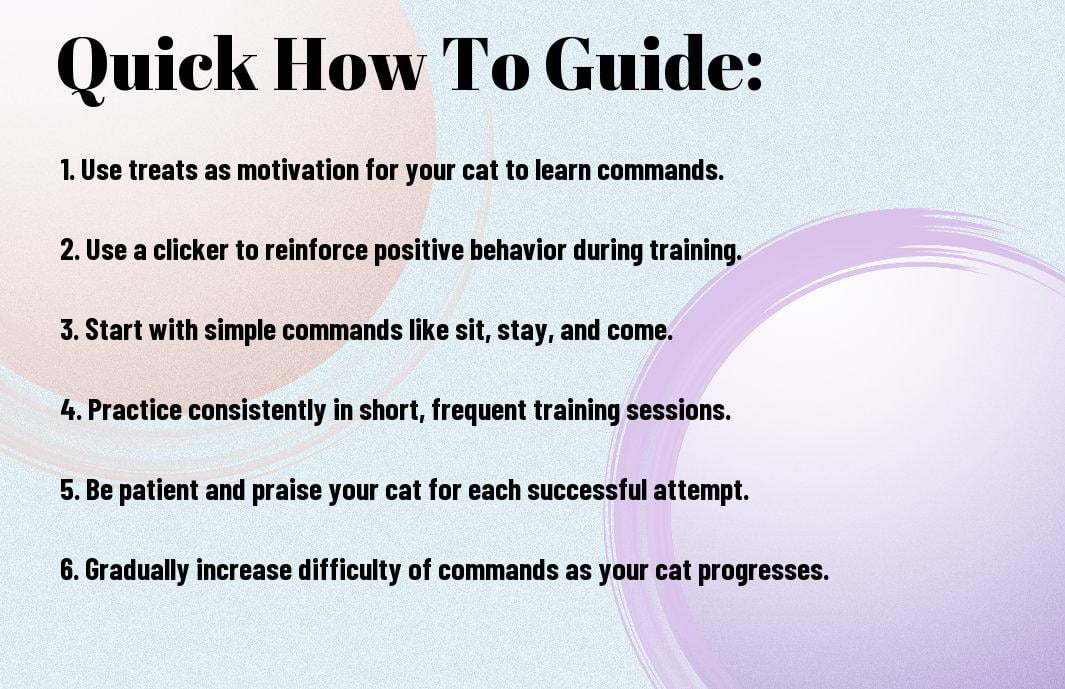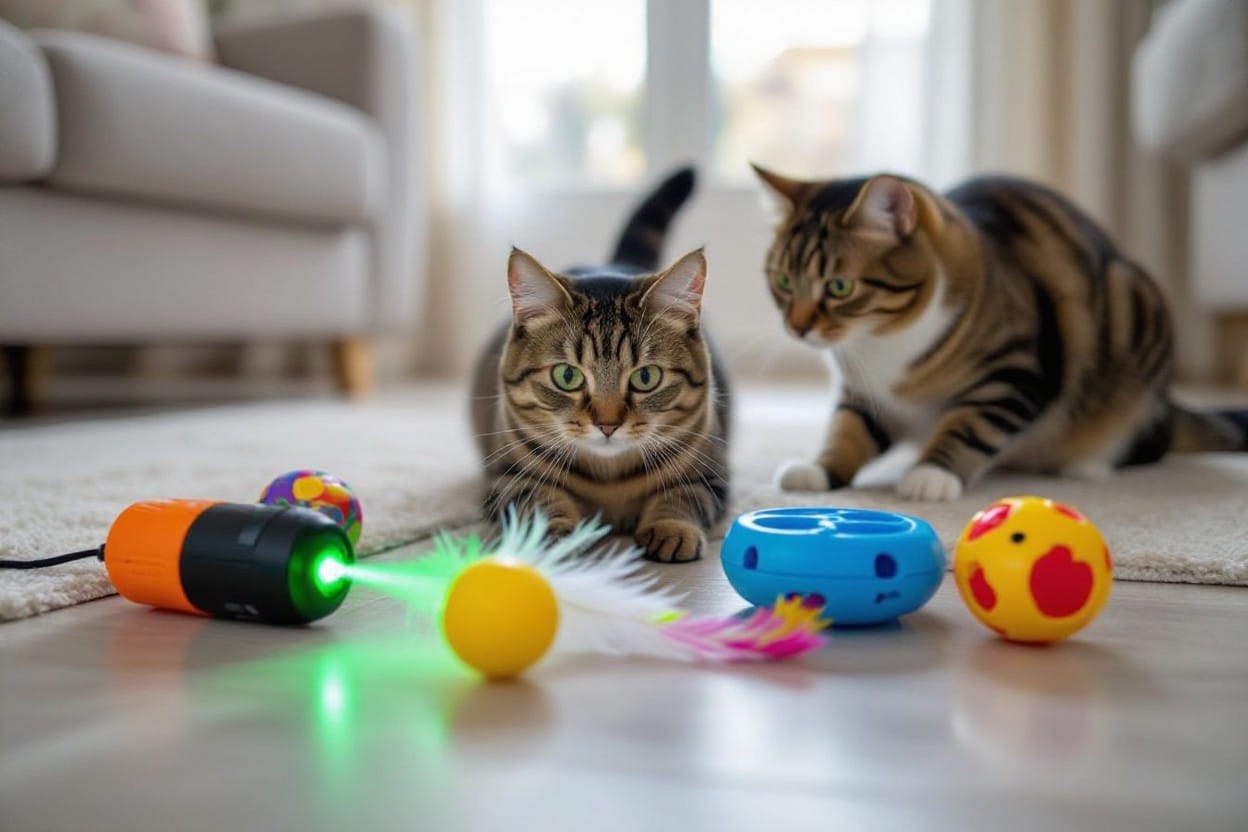Many cat owners believe that cats cannot be trained like dogs, but the reality is that cats are intelligent animals capable of learning basic commands and tricks. With patience, consistency, and the right approach, you can teach your feline friend to follow commands such as sit, stay, and even perform fun tricks like high-five or fetch. In this guide, we will walk you through the steps to successfully teach your cat basic commands and tricks that will not only strengthen your bond but also provide mental stimulation for your furry companion.


Preparing for Training
Essential Tools and Supplies for Cat Training
The first step in teaching your cat basic commands and tricks is to gather the necessary tools and supplies for training. These may include high-value treats such as small pieces of cooked chicken or commercial cat treats, a clicker for clicker training, a comfortable training area free of distractions, and patience.
Creating a Positive Learning Environment
Training your cat requires a positive and conducive learning environment. Make sure the training area is quiet, free from loud noises or other distractions that could disrupt the training session. Use positive reinforcement techniques such as treats, praise, and play to motivate and reward your cat for good behavior.
Training your cat may take time and patience, so it’s necessary to create a positive and safe space where your cat feels comfortable and willing to learn. Avoid any negative reinforcement or punishment, as this can cause stress and fear in your cat, hindering the training process. Do not forget, consistency and positive reinforcement are key to successful training sessions with your cat.
Understanding Feline Behavior and Body Language
To effectively train your cat, it’s crucial to understand feline behavior and body language. Cats communicate through subtle cues and body language, so learning to read your cat’s signals will help you modify your training techniques accordingly. For example, a cat may flatten its ears or twitch its tail when feeling anxious or stressed, signaling that it’s not the right time for training.
To
build a strong bond with your cat and improve communication during training sessions, take the time to observe and interpret your cat’s body language cues. This will enable you to adjust your training approach to suit your cat’s comfort level and learning style, ultimately leading to more successful training outcomes.
Basic Commands
How-To Teach ‘Sit’
Once again, teaching your cat basic commands can be a fun and rewarding experience for both you and your feline friend. A great place to start is by teaching your cat how to ‘sit’ on command. This can be a useful command for creating a sense of control and establishing boundaries with your cat.
Little by little, you can guide your cat into the ‘sit’ position by using a treat as a lure. Hold the treat close to your cat’s nose and slowly move it upwards and slightly behind their head. As their head follows the treat, their bottom will naturally lower into a sitting position. When they are fully seated, say the command ‘sit’ and reward them with the treat.
How-To Teach ‘Stay’
Now, let’s move on to teaching your cat how to ‘stay’. This command can be particularly useful in situations where you need your cat to remain in a specific spot for their safety or to prevent them from running out of the house.
Plus, teaching your cat to ‘stay’ can also help improve their overall obedience and focus. To teach ‘stay’, start by commanding your cat to ‘sit’. Once they are in a sitting position, hold your hand up with an open palm towards their face and say ‘stay’ in a firm and clear voice. Reward your cat if they stay put, even if it’s just for a few seconds in the beginning. Gradually increase the duration of the ‘stay’ as your cat becomes more adept at following the command.
Teaching Tricks
High-Five
Unlike dogs, cats are not known for their love of obedience. However, with patience and the right motivation, you can teach your feline friend some fun tricks. Teaching your cat to give you a high-five can be a rewarding experience for both of you. Start by getting your cat comfortable with your hand near their paw, using treats as positive reinforcement. Slowly guide their paw up towards your hand, and when they touch it, praise them and give them a treat. With consistent practice, your cat will soon be giving you high-fives on command!
Jump Through a Hoop
Clearly, teaching your cat to jump through a hoop is a more advanced trick that requires time and dedication. Start by introducing the hoop to your cat and getting them used to it being in their environment. Use a target stick or their favorite treat to lure them through the hoop. Gradually raise the hoop higher as they become more comfortable with the trick. With plenty of praise and rewards, your cat will eventually learn to jump through the hoop on cue.
To ensure your cat’s safety while learning to jump through a hoop, make sure the hoop is stable and secure. Never force your cat to do the trick if they seem scared or unwilling. Keep in mind, training should always be a positive and enjoyable experience for both you and your feline friend.
Advanced Training Techniques
All
- Clicker Training Fundamentals
To Clicker Training Fundamentals
Clicker training is a powerful method that uses a clicker tool to mark desired behaviors and reinforce them with a treat. This technique helps cats associate the sound of the clicker with receiving a reward, making the training process more effective and efficient. To start clicker training, introduce your cat to the clicker by clicking and offering a treat immediately after. Repeat this several times until your cat recognizes that the click equals a reward.
After your cat understands the association, you can begin teaching commands or tricks by clicking when your cat performs the desired behavior and rewarding them with a treat. Consistency is key with clicker training, so be sure to click and reward every time your cat successfully completes the task.
All
- Leash and Harness Training
Any Leash and Harness Training
Leash and harness training can provide your cat with safe outdoor experiences and enrichment. Start by introducing your cat to the harness in a positive way, allowing them to sniff and explore it before putting it on. Once your cat is comfortable with the harness, gradually introduce the leash indoors, allowing them to drag it around to get used to the feeling.
When your cat is comfortable with both the harness and leash, you can begin taking short walks around the house or yard. Remember to always supervise your cat while they are wearing the harness and leash to ensure their safety. With patience and consistency, you can teach your cat to walk on a leash and enjoy the outdoors together.
Consistency: Consistency is key in leash and harness training. Ensure that you use the same commands and rewards each time you practice with your cat. This will help reinforce positive behaviors and make the training process more effective.

Addressing Behavioral Issues
Biting and Scratching
Clearly, biting and scratching are common behaviors in cats. To address this issue, it’s necessary to understand the reasons behind these actions. Cats may bite or scratch out of fear, overstimulation, playfulness, or to establish boundaries. When your cat displays these behaviors, it’s crucial not to punish them physically. Instead, use redirection techniques by offering them a toy or scratching post to deter them from using your hands or furniture as a target.
Litter Box Training
Identifying the root cause of your cat’s reluctance to use the litter box is the first step in addressing this issue. Ensure the litter box is clean, placed in a quiet and accessible location, and the right size for your cat. Cats are meticulous animals and may avoid using a dirty or unappealing litter box.
Plus, some cats may have aversions to the type of litter being used. Experiment with different textures and materials to see what your cat prefers. Consistency and positive reinforcement are key when training your cat to use the litter box correctly. Avoid scolding or punishing your cat for accidents, as this can create a negative association with the litter box.
Ongoing Training and Maintenance
Keeping Your Cat Mentally Stimulated
Despite successfully teaching your cat basic commands and tricks, it is important to continue providing mental stimulation to keep your feline friend engaged and happy. Cats are intelligent creatures that thrive on mental challenges, so it is crucial to offer a variety of activities to prevent boredom.
Assuming your cat has mastered the basic commands, you can introduce new tricks or puzzles to keep their mind sharp. Interactive toys, puzzle feeders, and even DIY obstacle courses can provide your cat with the mental exercise they need to stay sharp and content.
Tracking Progress and Setting Goals
Progress in cat training can vary from one cat to another, so it is important to track your cat’s progress and set realistic goals. Keep a training journal to record each session’s outcomes, including what commands or tricks your cat has mastered and any challenges faced.
Setting goals for your cat’s training can help keep you motivated and give you a clear direction on what to work on next. Whether it’s improving the accuracy of a command or introducing a new trick, having goals in mind will help you and your cat stay focused during training sessions.
Final Words
With these considerations in mind, teaching your cat basic commands and tricks can be a rewarding experience for both you and your feline friend. Remember to be patient, use positive reinforcement, and make training sessions short and fun. Consistency is key, so stick to a routine and practice regularly to see the best results.
By following the tips and techniques outlined in this guide, you can help your cat learn new skills and behaviors that will strengthen your bond and enrich your relationship. With time, patience, and a little bit of creativity, you can train your cat to do everything from sitting on command to performing fun tricks that will impress your friends and family.
FAQ
Q: Why is it important to teach your cat basic commands and tricks?
A: Teaching your cat basic commands and tricks not only strengthens the bond between you and your feline friend, but it can also help with mental stimulation and provide enrichment for their daily lives.
Q: What are some basic commands you can teach your cat?
A: Some basic commands you can teach your cat include “sit,” “stay,” “come,” “shake,” and “high five.” These commands are not only fun but can also be useful in managing your cat’s behavior.
Q: How do you train a cat to respond to basic commands?
A: Training a cat to respond to basic commands requires patience, consistency, and positive reinforcement. You can use treats, clicker training, or toys to reward and encourage desired behaviors.
Q: Can all cats learn basic commands and tricks?
A: Yes, all cats are capable of learning basic commands and tricks. However, some cats may be more motivated by food rewards, while others may prefer play or praise as positive reinforcement.
Q: How long does it take to teach a cat basic commands and tricks?
A: The time it takes to teach a cat basic commands and tricks can vary depending on the individual cat’s personality and motivation. Some cats may learn quickly within a few weeks, while others may take longer. Consistent training sessions and patience are key to successful training.

















